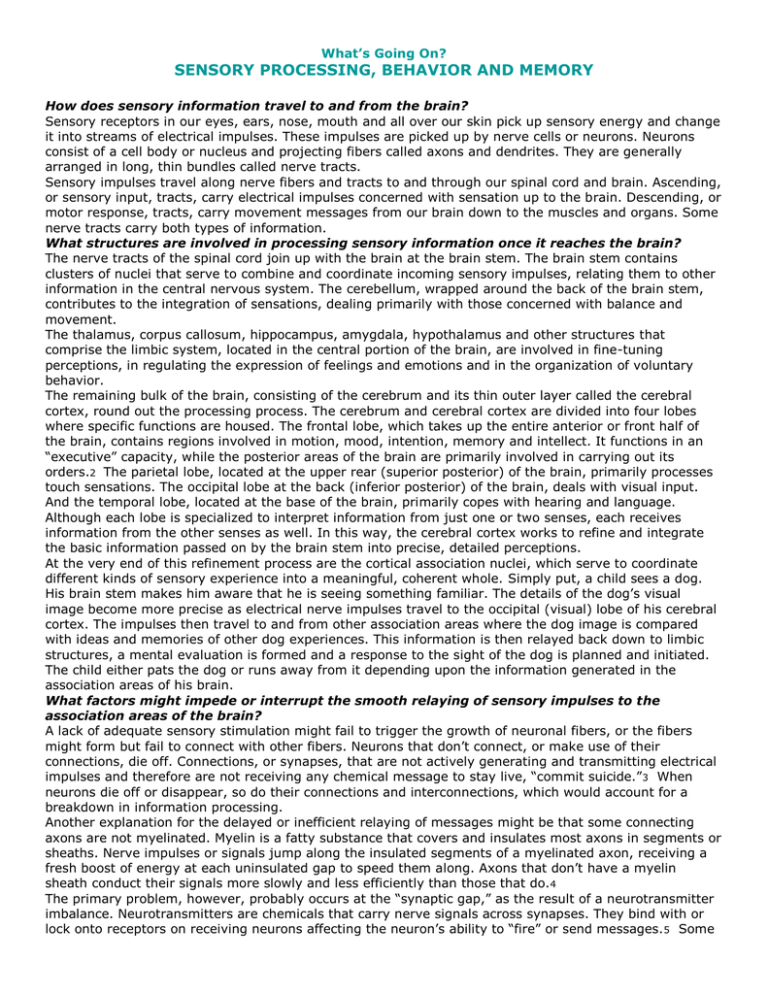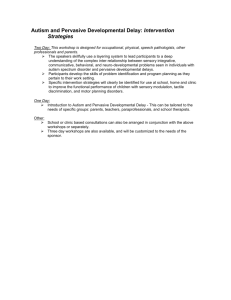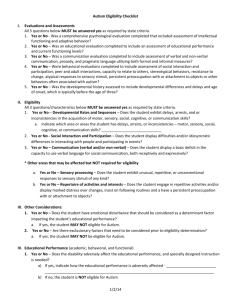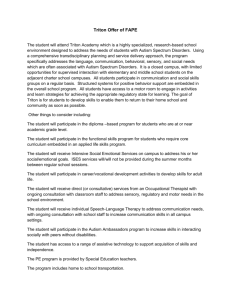
What’s Going On?
SENSORY PROCESSING, BEHAVIOR AND MEMORY
How does sensory information travel to and from the brain?
Sensory receptors in our eyes, ears, nose, mouth and all over our skin pick up sensory energy and change
it into streams of electrical impulses. These impulses are picked up by nerve cells or neurons. Neurons
consist of a cell body or nucleus and projecting fibers called axons and dendrites. They are generally
arranged in long, thin bundles called nerve tracts.
Sensory impulses travel along nerve fibers and tracts to and through our spinal cord and brain. Ascending,
or sensory input, tracts, carry electrical impulses concerned with sensation up to the brain. Descending, or
motor response, tracts, carry movement messages from our brain down to the muscles and organs. Some
nerve tracts carry both types of information.
What structures are involved in processing sensory information once it reaches the brain?
The nerve tracts of the spinal cord join up with the brain at the brain stem. The brain stem contains
clusters of nuclei that serve to combine and coordinate incoming sensory impulses, relating them to other
information in the central nervous system. The cerebellum, wrapped around the back of the brain stem,
contributes to the integration of sensations, dealing primarily with those concerned with balance and
movement.
The thalamus, corpus callosum, hippocampus, amygdala, hypothalamus and other structures that
comprise the limbic system, located in the central portion of the brain, are involved in fine-tuning
perceptions, in regulating the expression of feelings and emotions and in the organization of voluntary
behavior.
The remaining bulk of the brain, consisting of the cerebrum and its thin outer layer called the cerebral
cortex, round out the processing process. The cerebrum and cerebral cortex are divided into four lobes
where specific functions are housed. The frontal lobe, which takes up the entire anterior or front half of
the brain, contains regions involved in motion, mood, intention, memory and intellect. It functions in an
“executive” capacity, while the posterior areas of the brain are primarily involved in carrying out its
orders.2 The parietal lobe, located at the upper rear (superior posterior) of the brain, primarily processes
touch sensations. The occipital lobe at the back (inferior posterior) of the brain, deals with visual input.
And the temporal lobe, located at the base of the brain, primarily copes with hearing and language.
Although each lobe is specialized to interpret information from just one or two senses, each receives
information from the other senses as well. In this way, the cerebral cortex works to refine and integrate
the basic information passed on by the brain stem into precise, detailed perceptions.
At the very end of this refinement process are the cortical association nuclei, which serve to coordinate
different kinds of sensory experience into a meaningful, coherent whole. Simply put, a child sees a dog.
His brain stem makes him aware that he is seeing something familiar. The details of the dog’s visual
image become more precise as electrical nerve impulses travel to the occipital (visual) lobe of his cerebral
cortex. The impulses then travel to and from other association areas where the dog image is compared
with ideas and memories of other dog experiences. This information is then relayed back down to limbic
structures, a mental evaluation is formed and a response to the sight of the dog is planned and initiated.
The child either pats the dog or runs away from it depending upon the information generated in the
association areas of his brain.
What factors might impede or interrupt the smooth relaying of sensory impulses to the
association areas of the brain?
A lack of adequate sensory stimulation might fail to trigger the growth of neuronal fibers, or the fibers
might form but fail to connect with other fibers. Neurons that don’t connect, or make use of their
connections, die off. Connections, or synapses, that are not actively generating and transmitting electrical
impulses and therefore are not receiving any chemical message to stay live, “commit suicide.” 3 When
neurons die off or disappear, so do their connections and interconnections, which would account for a
breakdown in information processing.
Another explanation for the delayed or inefficient relaying of messages might be that some connecting
axons are not myelinated. Myelin is a fatty substance that covers and insulates most axons in segments or
sheaths. Nerve impulses or signals jump along the insulated segments of a myelinated axon, receiving a
fresh boost of energy at each uninsulated gap to speed them along. Axons that don’t have a myelin
sheath conduct their signals more slowly and less efficiently than those that do. 4
The primary problem, however, probably occurs at the “synaptic gap,” as the result of a neurotransmitter
imbalance. Neurotransmitters are chemicals that carry nerve signals across synapses. They bind with or
lock onto receptors on receiving neurons affecting the neuron’s ability to “fire” or send messages. 5 Some
neurotransmitter molecules released into synaptic gaps are excitatory or facilitatory, making neurons
more likely to fire, while others are inhibitory, making them less likely to fire. 6
The combination of facilitatory and inhibitory messages produces modulation, which is the nervous
system’s process of self-organization.7 An imbalance in neurotransmitter levels would adversely affect the
conductivity of the synapses, affecting both the modulation and communication of input and throwing the
entire nervous system out of kilter. The crucial neural message sending activity within the brain would
either be slowed, speeded or interrupted, making it exceedingly difficult for neural impulses to stay on
track and on target.
What might happen to sensory impulses in the autistic brain?
From the brain stem, every impulse or message divides and subdivides through a complex maze of nerve
fibers and across countless millions of synapses en route to the association areas of the cortex. An
appropriate perception and response behavior is produced only if these impulses stay on track. If they
veer off, if they miss a synapse or two along the way, if they get lost or held up somewhere along the line,
resulting perceptions would be fragmented, their meaning distorted or incoherent, and response behavior
would be delayed and, more often than not, abnormal or inappropriate. I believe this is what happens in
autism.
Uta Frith asserts that in autism, “there is hazard, followed by havoc, followed by harm.” 8 If we assume
that the underlying problem is a faulty neural connection forming mechanism (hazard), than
neurotransmitters could certainly be implicated in causing the havoc. At every step along the way, one or
more of these brain chemicals kick in to impede or wreak modulatory havoc on synaptic processing by
failing to provide the proper amount of stimulation. This results in serious neurological harm as
connections fail to form or function, and neurons in key processing points, like the limbic system, fail to
thrive or die off. Because of a connection network that is incomplete or dysfunctional, the thought process
is incomplete and, consequently, atypical.
Why are the association nuclei particularly susceptible to impairment due to a breakdown in
synaptic processing?
The cerebral cortex is comprised of densely packed neuron nuclei, while the cerebrum consists of the
fibers or axons of these nuclei. Specifically, it consists of projection fibers which connect the left and right
brain hemispheres and convey impulses back down to the brain stem and cerebellum via the thalamus
and limbic structures. It also consists of short association fibers that link adjacent areas of the cortex to
one another and of long association tracts that convey signals from lobe to lobe, connecting anterior and
posterior cortical regions.9
In the cerebrum, these long association tracts are most susceptible to synaptic dysfunction because of
their complexity and the number of synapses involved. If any connections along these tracts are impaired,
neural communication would be slowed or shortcircuited, resulting in a deterioration of the nerve cells
receiving the transmission. Many of the nerve cells receiving input from these tracts are located in the
limbic system and cerebellum, which are responsible for planning and coordinating motor responses,
perceptions and intentional behavior.
How does this breakdown in processing jive with the findings of neuroanatomical studies of
autistic brains?
Although there is much we don’t know about the pathology of autism, high-tech neuroanatomical research
has come up with a few key findings. One of the most significant is in the limbic system, particularly in
areas of the amygdala and hippocampus, where neural cells have been found to be abnormally small and
tightly packed.10
Both findings are consistent with a lack of adequate stimulation; nerve cells surviving but failing to sprout
as many bulky, myelinated connecting fibers as normally sized and spaced cells. Functional MRI studies on
autistic brains have revealed areas of the amygdala filled with cerebral spinal fluid, confirming a lack of
brain activity in parts of this structure. Brain activity increases blood flow and oxygen delivery to regions
of the brain. Those regions failing to receive enough oxygen fill with fluid.
Autopsy research has also revealed both cerebellar cell loss and immature neuron development in autistic
specimens; findings that can also be explained by a breakdown in neural communication; cells not
developing or dying off because they are not receiving enough feedback to keep them active and alive. A
congenital reduction in the number of cerebellar Purkinje cells with preserved olivary neurons may indicate
that the neurological damage resulting in autism occurs in the first trimester of prenatal development. 11
Age related anatomical changes in neuron size and number in the cerebellum and brain stem inferior olive
indicate that the neuropathology of autism is probably an ongoing process that continues into adulthood.
How might these cerebellar and limbic system findings cause or contribute to autism?
It is more difficult to correlate the autopsy findings in the cerebellum to the clinical features of autism than
it is to link impaired limbic system structures to the syndrome. It is possible that, in addition to its
involvement in balance and coordination, the cerebellum plays a role in the areas of emotion, cognition,
behavior, mental imagery, anticipatory planning, spatial orientation and some aspects of language
processing and attention.
More compelling and clear-cut is the correspondence between behaviors seen in autism and the limbic
system’s recognized roles in memory, emotion and social expression. Specifically, the amygdala controls
aggression and emotions, which ties into both the aggressive and self-abusive behaviors of some autistic
individuals, as well as their extreme passivity and appearance of being emotionless or “flat.” Neuronal
activity in the amygdala is related to memory formation, especially under conditions of emotional arousal.
Experiments have shown that when their amygdala is removed or damaged, animals exhibit autistic-like
behaviors, including social withdrawal, compulsivity, loss of fear of normally aversive stimuli, difficulty
adjusting to novel situations and difficulty retrieving information from memory. Additionally, the amygdala
is highly responsive to a variety of sensory stimuli, such as sounds, sights and smells.
The hippocampus, the other limbic structure evidencing neural abnormalities, is primarily responsible for
learning and memory. Damage to or removal of this structure results in an inability to store new
information into memory, as well as in stereotypic and self-stimulatory motor behavior, hyperactivity and
disordered responses to novel stimuli.
All three brain structures (cerebellum, amygdala and hippocampus) play some role in the laying down of
memory.
What do we know, or think we know, about memory?
Memory is far more than just a vast store of mental images or representations of past experiences. Not
only are most memories, not stored as images, but recent studies have cast doubts on the premise that
any memories are representational. The one thing that is certain about memory is that it is a complicated
business; a product of the activity of numerous neuronal networks in the brain.
Memories are formed by a strengthening of the communicative links between neurons. The stronger the
links, the stronger the memory. Association comes into play in that the more links there are to other
similar facts, the more substantive a memory is and the more easily it is recalled.(M,130) Of course,
chemical changes, the synaptic activity of neurotransmitters, underlie the formation of all memories,
whether they involve the laying down of basic skills or the mastery of a foreign language.
Not only is the memorization process different for these two types of learning, but the areas of the brain
involved in the process are different. Procedural memories, which involve the acquisition of motor skills or
abilities through repeated trials are formed primarily in the cerebellum, while declarative memories,
involving the integration, internalization and generalization of factual information and experience, have
their genesis in the amygdala and hippocampus of the limbic system. These memories are then screened
by the thalamus and stored in the frontal cortex. Declarative memories having to do with language or
significant events, along with the ability to recognize familiar faces, are filed away in the left temporal
lobe.
These are all forms of long-term memory, but our brains must also accommodate short-term memories,
which enable us to put together a coherent sentence, do a math calculation or remember our place in a
book we are reading. These memories, which are sorted and filtered through the thalamus, involve a
collaboration of phonological, visual-spatial and executive capacities.131
In autism, procedural (or rote) memory, which presents very early in development and involves less
neural circuitry, appears to be more or less intact. The problem lies in the laying down of declarative
memories, which comprise all sensory modalities and mediate the processing of all facts and experience.
This latter memory system is highly associative, involving the integration. internalization and
generalization of all types of information.
How does the short-circuiting of sensory impulses affect memory and intentional behavior in
autism?
Brain function is hierarchically organized. Sensorimotor activities are carried out by individual neurons in
networks, whereas perceptual insights leading to intentional behavior are organized by large masses of
neurons. The association nuclei in the limbic system are the highest echelon in the information processing
hierarchy. If sensory impulses are somehow impeded from reaching these final organizational nuclei, or if
there are too few nuclei to do the job, the meaning of sensations or perceptions would be skewed or
incomplete -- as they are in autism. And if perceptions are “off,” than responses to those perceptions--in
the form of actions, emotions or behavior -- are bound to be “off.”
If memories are formed by a strengthening of the synaptic connections between neurons that are
activated in specific patterns as a result of learning and experience, it follows that any problem with
neuronal or synaptic dynamics would cause a problem with remembering or with relating new information
to previously stored information, as Dr. Bernard Rimland theorized in his book on Infantile Autism three
decades ago. And as “learning and memory constitute the fundamental processes of experience and
provide the substrates for cognition and adaptive behavior,” the lack of an intact, fully functional memory
system would severely impact both learning and intentional behavior as is the case in autism.
Works Cited
Ayres, Jean A. Sensory Integration and the Child. Los Angeles, California: Western Psychological Services,
1991.
Baker, Bruce, et.al. Behavior Problems. Champaign, Illinois: Research Press. 1976.
Bundy, Anita C., Anne G. Fisher, Elizabeth A. Murray. Sensory Integration: Theory and Practice.
Philadelphia, Pennsylvania: F.A. Davis Company, 1991.
Champe, Pamela C., Richard A. Harvey. Lippincott’s Illustrated Reviews: Biochemistry. Philadelphia,
Pennsylvania: J.B. Lippincott Company, 1994.
Dake, Lorelei, Sabrina Freeman. Teach Me Language. Langley, B.C. Canada: SKF Books, 1997.
Fouse, Beth, Maria Wheeler. A Treasure Chest of Behavioral Strategies for Individuals with Autism.
Arlington, Texas: Future Horizons, Inc., 1997.
Frith, Uta. Autism: Explaining the Enigma. Cambridge, Massachusetts: Blackwell Publishers Inc., 1996.
Grandin, Temple. Thinking In Pictures: And Other Reports from My Life with Autism. New York: Vintage
Books, 1996.
Greenfield, Susan A. The Human Mind Explained. New York: Henry Holt and Company, 1996.
Lovass, O. Ivar. Teaching Developmentally Disabled Children: The Me Book. Austin Texas: Pro Ed, Inc.,
1981.
Miller, Arnold and Eileen Eller. From Ritual to Repertoire: A Cognitive-Developmental Systems Approach
With Behavior Disordered Children. New York: John Wiley & Sons, 1989.
Quill, Kathleen Ann. Teaching Children With Autism: Strategies to Enhance Communication and
Socialization. New York: Delmar Publishers Inc., 1995.
Shaw, William. Biological Treatments for Autism and PDD. William Shaw PhD., 1998.
Siegel, Bryna. The World of the Autistic Child: Understanding and Treating Autistic Spectrum Disorders.
New York: Oxford University Press, 1996.
Williams, Donna. Nobody Nowhere: The Extraordinary Autobiography of an Autistic. New York: Times
Books, 1992.
Important Legal Notice / Disclaimer
Copyright © 2002 Gail Buckley/WebSuccessMaker.com - All Rights Reserved
The content of this book (and accompanying website) are copyrighted. No part of this e-book may be
reproduced or transmitted in any form whatsoever, be it of electronic or tangible nature, without written
permission from the author.
While every attempt has been make to ensure that the information presented here is correct, the contents
herein are a reflection of the views of the author and are meant for educational and informational
purposes only.
The author thereby assumes no culpability for any loss, personal or otherwise, caused by the use of the
information presented.
Copyright violators will be prosecuted to the fullest extent of the law.
About the Author
As the parent of an autistic child, Gail Buckley is uniquely qualified to write this book because she has
been immersed in the world of autism for seventeen years. She has been an active participant in every
aspect of her daughter’s development and education. Through her daughter, she has had experience with
three of the most renowned schools in the northeast for children with autism, so she is able to compare
and contrast the strengths and weaknesses of their various methodologies.
Over the years, Ms. Buckley has closely observed dozens of children with autism. She has picked the brain
of many a teacher, doctor and therapist and has conversed at length with the best sources of all, other
parents. In addition to her personal experience, she has read extensively on autism and on related
subjects and has kept abreast of the latest research on the autistic front via periodicals and the internet.
In short, Ms. Buckley has amassed a surfeit of knowledge and information from which she has drawn in
writing her book,Funny Wiring: Living With and Piecing Together the Puzzle of Autism.
Gail Buckley graduated with a BS from Cornell University. She currently lives in Lynnfield with her
husband, Brian, and two children, Meaghan and Michael.
http://www.funnywiring.com/sensory_processing.htm









